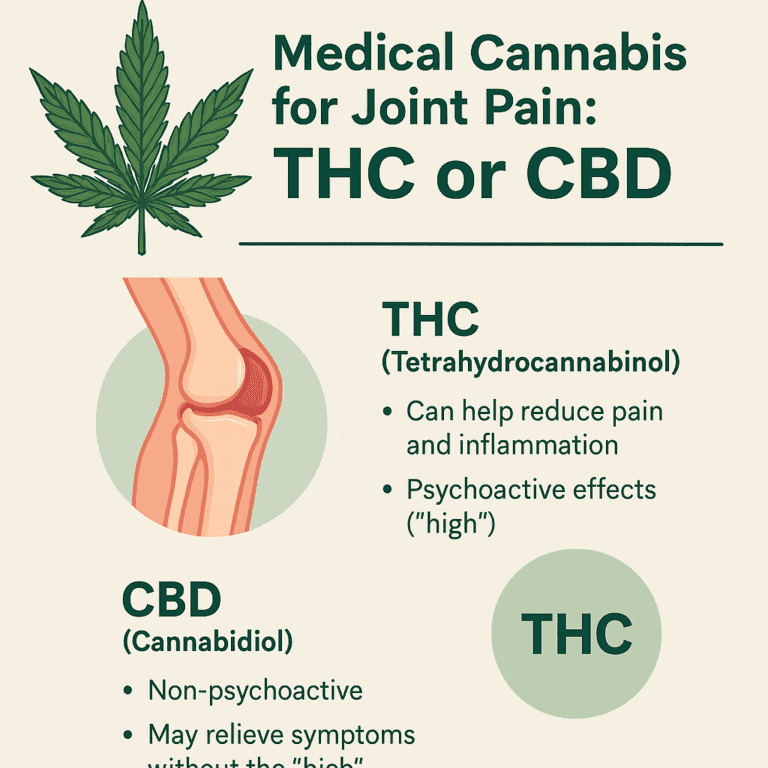Medical cannabis has become a popular choice for people looking to ease joint pain. Two key components, THC and CBD, are often used to manage discomfort.
While THC can help reduce pain and inflammation, CBD offers a non-psychoactive option that may soothe symptoms without the “high.” Understanding how these compounds work can help you find the relief you need.
If joint pain is holding you back, exploring medical cannabis could be a game-changer. Get your medical marijuana card for joint pain relief at TeleLeaf and discover how THC, CBD, or a combination of both may provide the comfort you’ve been seeking.
What Is Medical Cannabis?
Medical cannabis refers to the use of the cannabis plant or its chemical components to address health issues. Unlike adult-use cannabis, MMJ is used under the guidance of a healthcare provider. It eases symptoms of different conditions, including chronic pain, anxiety, and inflammation.
Medical cannabis is made up of two compounds: tetrahydrocannabinol (THC) and cannabidiol (CBD). These compounds interact with the body in different ways and have unique effects. Choosing the right one for joint pain relief depends on several factors: source of the pain, personal preferences, and tolerance levels.
Understanding THC and CBD
THC (Tetrahydrocannabinol)
THC is the psychoactive compound in medical cannabis that produces the sensation associated with being “high.” It binds to specific receptors in the brain and nervous system, influencing mood, perception, and pain regulation. For joint pain sufferers, THC’s ability to alter pain perception can be particularly useful.
- Benefits for Joint Pain: THC has strong analgesic (pain-relieving) and anti-inflammatory properties. It may help reduce discomfort caused by swelling and inflammation in the joints. Additionally, it can promote relaxation and improve sleep, which is often disrupted by chronic pain.
CBD (Cannabidiol)
CBD is a non-psychoactive compound, meaning it doesn’t cause a high. It works differently in the body. It interacts with receptors involved in reducing inflammation and promoting balance in the immune system.
- Benefits for Joint Pain: CBD’s anti-inflammatory properties are valuable for arthritis patients. It also has calming effects, which can help with stress and anxiety linked to chronic pain.
THC vs. CBD for Joint Pain: Which Is Better?
Using THC
THC can help patients with quick pain relief, especially for severe or acute joint pain. Because it interacts with receptors in the brain, it may offer immediate comfort by reducing the perception of pain. THC in cannabis helps people ease the discomfort from rheumatoid arthritis or post-injury pain.
Using CBD
CBD is better suited for patients seeking relief without the intoxicating effects. It helps manage chronic joint pain caused by long-term conditions like osteoarthritis. CBD products come in different forms, such as oils, creams, or capsules.
Combining THC and CBD
Many patients find that a combination of THC and CBD works best. When used together, these compounds may enhance each other’s benefits—a phenomenon known as the entourage effect.
For example, CBD may reduce the psychoactive effects of THC, allowing users to experience pain relief without feeling intoxicated. This balance can be ideal for managing joint pain while maintaining daily activities.
Methods of Using Medical Cannabis for Joint Pain
Medical cannabis products come in different forms, each with its own advantages and considerations.
Here are some popular options for joint pain relief:
1. Topicals
Topical products like creams, balms, and lotions infused with CBD or THC can be applied directly to the affected joint. They offer localized relief without entering the bloodstream. Best for patients who prefer non-intoxicating options.
- Pros: Easy to use, no psychoactive effects, targets specific areas.
- Cons: May not provide relief for deeper pain.
2. Tinctures and Oils
Tinctures and oils are applied under the tongue or added to food and drinks. They allow for precise dosing and quick absorption into the bloodstream.
- Pros: Quick relief, easy to adjust dosage.
- Cons: Effects may vary based on the patient’s metabolism.
3. Edibles
Edibles such as gummies, chocolates, and beverages are infused with THC, CBD, or both. They provide a discreet and tasty way to consume medical cannabis but have a delayed onset of effects.
- Pros: Long-lasting effects, discreet consumption.
- Cons: Takes longer to feel relief (30 minutes to 2 hours).
4. Inhalation
Inhalation methods, such as vaping or smoking, deliver THC and CBD to the bloodstream almost immediately. For patients that need quick relief.
- Pros: Fast-acting, effective for acute pain.
- Cons: May irritate the lungs; not ideal for long-term use.
How to Choose the Right Product
When deciding between THC and CBD—or a combination—it’s important to take the following factors into account:
- Severity of Pain: For moderate to severe pain, THC or a THC-CBD blend may work better. For mild or chronic discomfort, CBD alone may suffice.
- Tolerance to Psychoactive Effects: If you prefer to avoid any intoxicating effects, stick to CBD products or low-THC formulations.
- Application Method: Choose a method that fits your lifestyle and the type of relief you need—topicals for localized pain or edibles for long-lasting effects.
Final Thoughts
Whether you choose THC, CBD, or a combination of both, understanding how these compounds work can help you make an informed decision.
Always start with low doses, track how your body responds, and consult with a healthcare professional for personalized advice. With the right approach, medical cannabis can be a valuable tool for managing joint pain and improving quality of life.
